- Home
- Sicilian Food
The Rich Flavors of mediterranean: A Culinary Journey Through Sicilian Food
 Food markets are great places to do your shopping.
Food markets are great places to do your shopping.Sicilian food is a fascinating blend of culinary traditions. The island's strategic location in the heart of the Mediterranean has given birth to a unique fusion of Italian, North African, and Greek cuisine. Coupled with the island's renowned fertile soil, this culinary melting pot also offers diverse fresh ingredients to seduce your taste buds.
Wander around local markets like Ballaro and Capo in Palermo to immerse yourself in the abundance of food products. The air is filled with the scent of fresh ingredients. You'll find everything from herbs and nuts to numerous sea creatures, vegetables, fruits, and meats around you.
Embark on a journey through the depths of authentic Sicilian food, and you'll not only savor delectable dishes but also witness the profound passion of its people. Sicilians take immense pride in sharing their rich culinary heritage, a sentiment that transcends mere food appreciation.
This journey through Sicily's rich flavors promises to awaken your senses, fostering a deep connection with the island's culture.

The Historical Influences on Sicilian Food
Sicilian cuisine is a product of thousands of years of history. Like the island's culture in general, Sicilian food has been shaped by the diverse array of peoples who have called it their home, from the Greeks to the Romans, Arabs, Jews, Normans, and Spaniards, as well as modern-day Italy.
The Greeks brought olive oil, wine, and honey, which are still essential ingredients in Sicilian cuisine today. The Romans were responsible for bringing in much of the wheat products, most notably bread.
The most significant impact, however, was on the Arabs. They ruled Sicily from the 9th to the 11th century. They brought a wide range of different foods and cooking techniques that revolutionized local cuisine forever.
The Arabs brought citrus fruits, which Sicily is still famous for, to the island. They also brought food items such as rice, sugar, and various spices, such as saffron and cinnamon - all standard ingredients today.
The Arabs also deserve credit for renewing the soil, which had been rendered almost uncultivable by Roman intensive farming. New irrigation systems and crop rotation agriculture, among other things, helped with that.
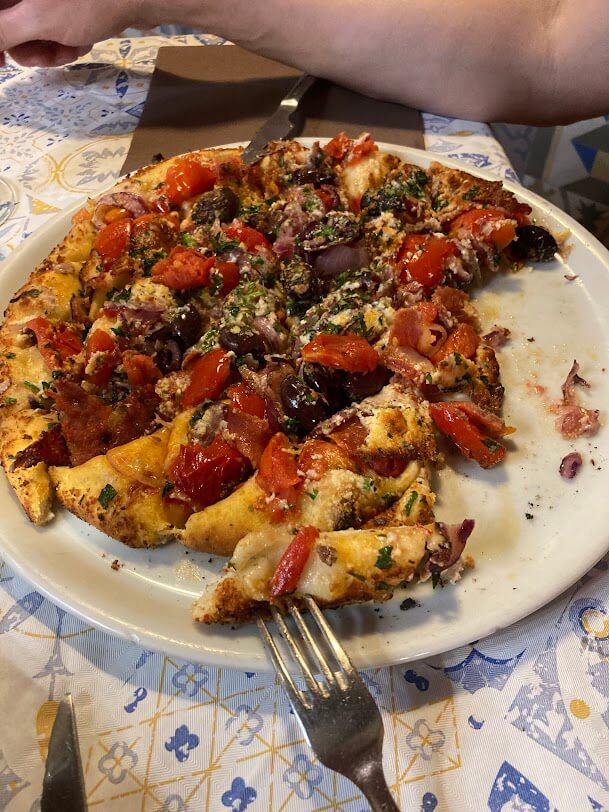 North African-flavored pizza in Trapani. The Arab influence is most notable in the western parts of the island.
North African-flavored pizza in Trapani. The Arab influence is most notable in the western parts of the island.The Normans and Spaniards further enriched Sicilian cuisine with their own contributions. The Normans introduced a variety of meats and cheeses. At the same time, the Spaniards brought tomatoes, chocolate, and maize from the New World.
This blend of cultures has resulted in a unique culinary tradition that is varied and deeply rooted in history. Sicilian food offers a palate of flavors as diverse as the island's storied past. The confluence of these influences makes Sicilian food a captivating mosaic of tastes and textures, reflecting the island's dynamic history.
Key Ingredients in Sicilian Cooking
The vibrant flavors of Sicilian cuisine are built upon a foundation of key ingredients that are as distinctive as they are essential. Olive oil is the cornerstone of many Sicilian dishes. It imparts a rich, fruity flavor that enhances everything from salads to stews.
Like so many other ingredients, the secret of local olive oil lies in Sicily's abundant sunshine and fertile soil. These elements also contribute to the island's delicious tomatoes, oranges, and wines.
Not so surprisingly, seafood is another pillar of Sicilian cuisine. After all, Sicily is an island surrounded by the Mediterranean Sea. Various fresh fish, squid, and shellfish are constants in Sicilian cooking.
These and many other seafood products can be admired at the local market. Anchovies, tuna, and swordfish lay there surrounded by many more exotic creatures.
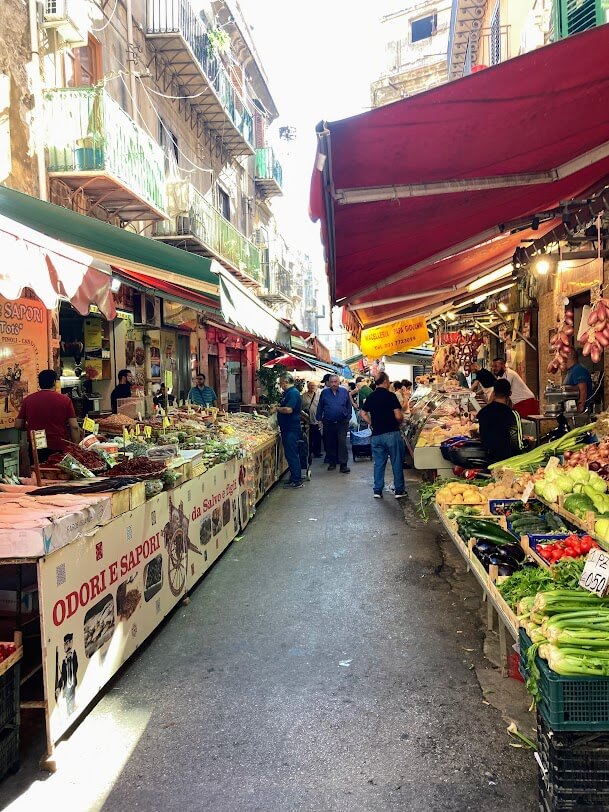 Ballaro Market in Palermo.
Ballaro Market in Palermo.Herbs and spices play a crucial role in Sicilian cooking, adding depth and complexity to dishes. Basil, oregano, and rosemary are frequently used, as are capers and olives, which are integral to many recipes.
The Arab influence is evident in using spices such as saffron, cinnamon, and cloves, which lend a unique warmth and aroma to the cuisine. Combined with the freshest local produce, these ingredients create a symphony of flavors unmistakably Sicilian, making each meal a celebration of the island's rich culinary heritage.
Traditional Sicilian Dishes to Try
Now, let's take a look at the most legendary Sicilian dishes.
Arancinos are crispy fried rice balls traditionally filled with meat, peas, and cheese—among other ingredients. Nowadays, they are also available in vegetarian versions. They are a delicious and easily portable snack with a history dating back a thousand years.
Because of their worldwide fame, arancini are sold everywhere, especially where tourists abound. However, the quality varies. It's worth checking where locals buy their arancini and head there.
Caponata is a vegetable stew with eggplant as the main ingredient. It can be served with meat and cheese. Caponata can be used in many ways, such as an appetizer, side dish, main course - or even a burger sauce.
And speaking of eggplants, what could be more Sicilian than Pasta alla Norma. Named after Bellini's famous opera, the dish consists of pasta, fried eggplants, tomato sauce, basil, and ricotta salata cheese.
Similarly legendary is Pasta con le Sarde, a sardine pasta. In addition to these small fish, fennel, pine nuts, and raisins add to the flavor symphony. The end result is salty-sweet, unique, and delicious.
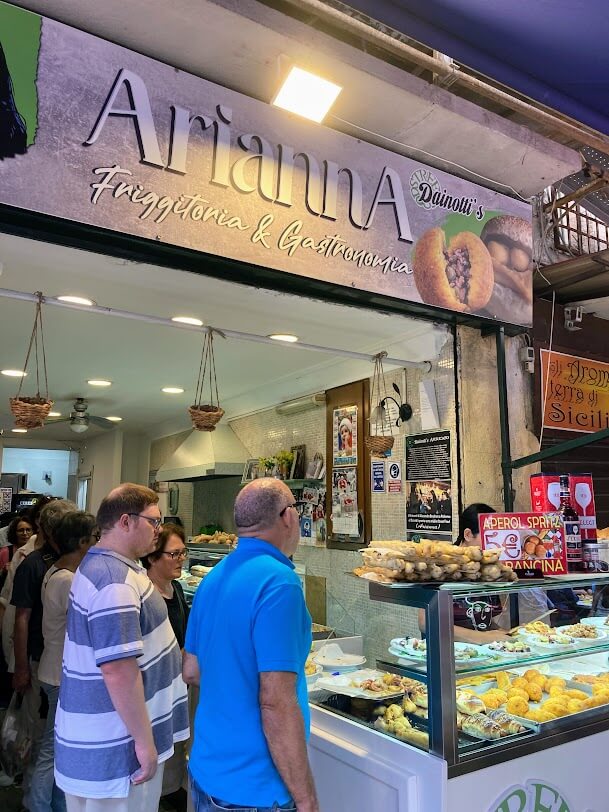 Buying nonna's home food in Capo Market.
Buying nonna's home food in Capo Market.The Arabs brought sugar to Sicily over a thousand years ago. Since then, the island has had a strong tradition of desserts and other delicacies.
The most famous is cannolo, a sweet cheese bomb baked in crispy dough. Another famous sweet is Cassata, a cake made with ricotta cheese, marzipan, and caramelized fruit.
These and many other dishes offer a glimpse into the secrets of Sicilian cuisine. It is worth noting that there is no right way to make any of these.
Or there is, but depending on who you ask, it's always different. Every town, family, and eatery can have their own version - which is always the best if you ask those involved.
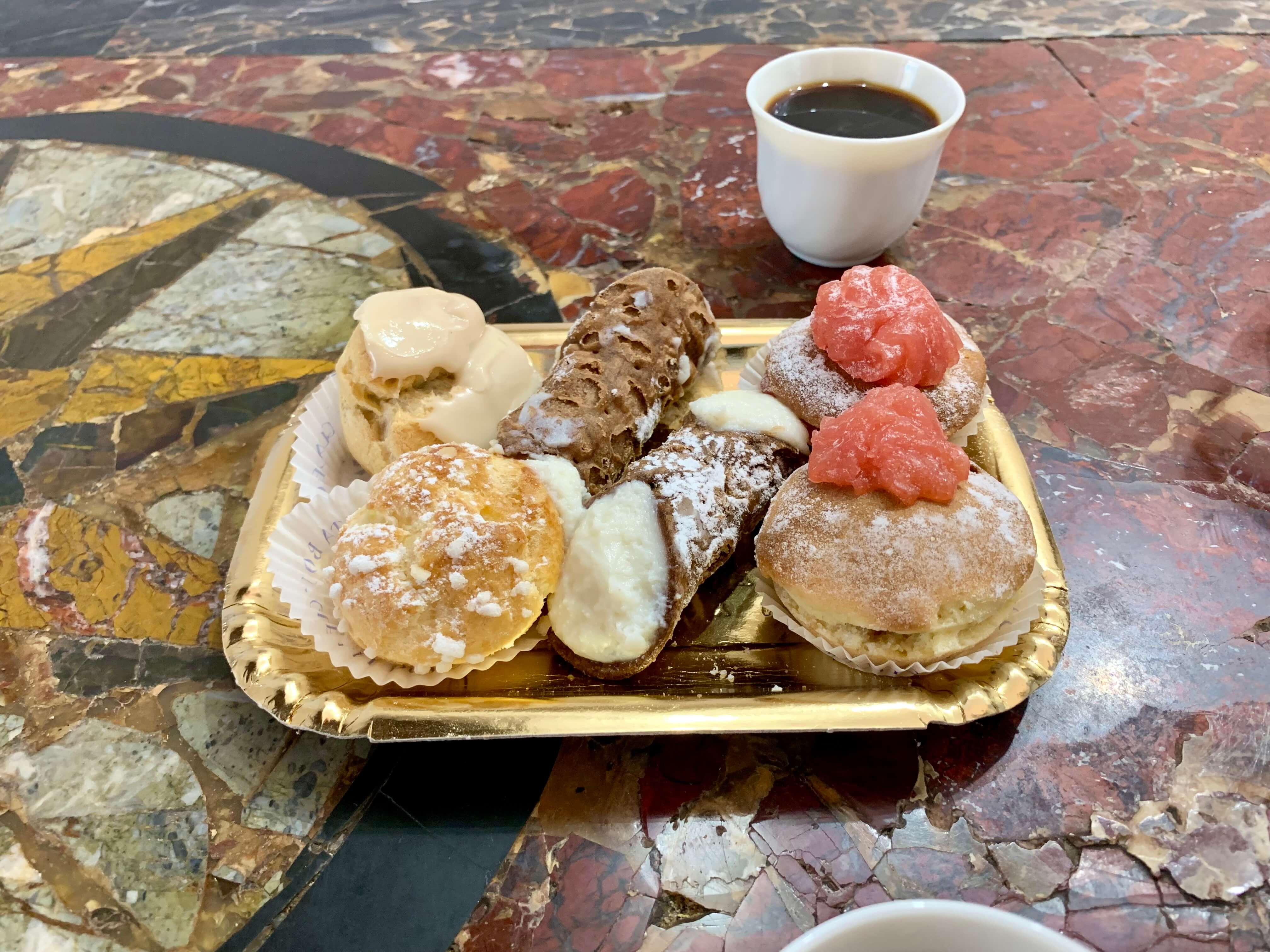 Sicilian sweet treats.
Sicilian sweet treats.Exploring Sicilian Street Food
When talking about Sicilian food, you can't ignore its street food tradition. Palermo, in particular, is known for its street food scene. Still, you can enjoy these greasy delicacies in other cities, too.
One of the most popular street foods is the 'panelle.' These crispy chickpea snacks, made from a paste of chickpea flour, water, and salt, are deep-fried and sprinkled with fresh lemon juice. Other street food delicacies not to miss include 'arancini,' 'sfincione,' and 'crocchè.'
Arancinos are crispy rice balls, as mentioned before.
Sfincione,' also known as Sicilian pizza, has a thick, fluffy base topped with tomato sauce, onions, and anchovies.
Crocches are potatoes fried until crispy on top—they are some of the oldest examples of Palermo's street food scene.
Grilled lamb and veal intestines are called 'stigghiola.' You can find this more adventurous experience also on Palermo's street grills.
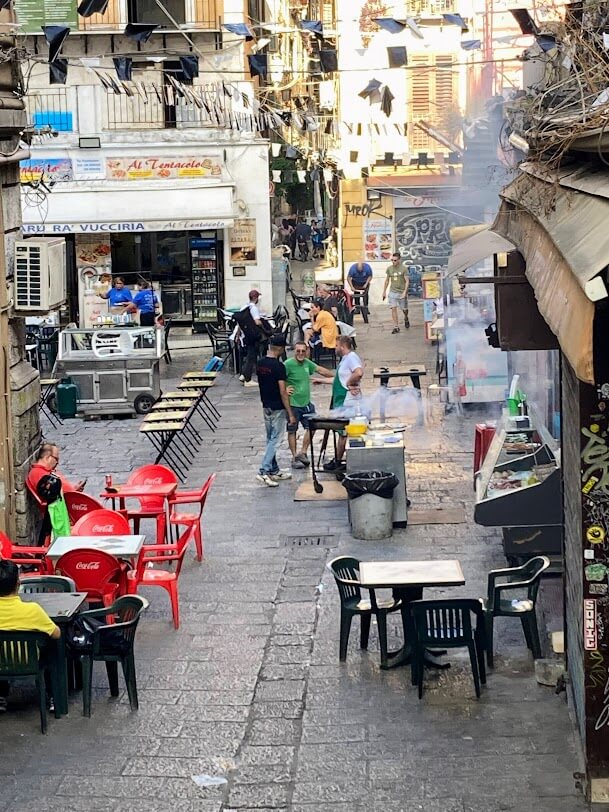 Street grills in Vucciria Market waiting for the evening to start.
Street grills in Vucciria Market waiting for the evening to start.The Importance of Wine in Sicilian Culture
Wine is a central part of Sicilian culture, a tradition that dates back to ancient times. The island's favorable climate, with its abundant sunshine and fertile volcanic soil, provides ideal conditions for viticulture.
Sicily is home to some of the oldest wine-producing regions in the world, and its wines are celebrated for their quality and diversity. From robust reds to crisp whites and sweet dessert wines, Sicilian wines offer a range of flavors that perfectly complement the island's cuisine.
Nero d'Avola, the "black wine of Avola," is the most famous Sicilian red wine. With its deep color and rich, fruity flavors, this full-bodied wine perfectly matches the island's hearty meat and tomato-based dishes.
Another notable red is Etna Rosso, produced on the slopes of Mount Etna. This wine, made from the indigenous Nerello Mascalese grape, is known for its elegance and complexity, reflecting the unique terroir of the volcanic soil.
Sicily is also renowned for its white wines, particularly those made from the Grillo and Catarratto grapes. These wines are typically crisp and refreshing, with bright acidity and citrus notes, making them an excellent accompaniment to the island's seafood dishes.
Marsala, a fortified wine from the western part of the island, is another Sicilian gem. Often used in cooking, Marsala is also enjoyed as a dessert wine, with its sweet, nutty flavors providing a perfect end to a meal.
The rich diversity of Sicilian wines and the island's deep-rooted wine culture make wine an integral part of the Sicilian culinary experience.
(Tip: if you find it difficult to choose a wine from a shop shelf, get a bottle with a word “Corvo” in it. In my experience, these wines are good, without being too expensive. As for Marsalas, drier versions are better, unless you're specifically looking for a sweet wine for dessert.)
Sicilian Coffee Culture
And let's not forget Sicilian coffee, which – as in Italy in general – is truly delicious. Italians take their coffee seriously, which is reflected in the high quality across all price ranges.
You can read more about Sicilian coffee culture HERE. There, you'll also learn about local specialties such as cafe granita and caffe d'u parinnu.
 Sicilian gelato goes well with local coffee.
Sicilian gelato goes well with local coffee.Conclusion: Embracing the Flavors of Sicily
Sicily, with its rich history and diverse cultural influences, offers a culinary experience that is both unique and deeply rooted in tradition. From the historical influences that have shaped its cuisine to the key ingredients and iconic dishes that define it, Sicilian food is a celebration of the island's bounty and the creativity of its people.
The role of seafood, the vibrant street food scene, and the importance of wine further enrich this culinary tapestry, providing many flavors and experiences for food enthusiasts.
In embracing Sicily's flavors, one discovers a variety of delectable dishes and the warmth and hospitality of its people, who take pride in sharing their culinary traditions.
This journey through Sicily's rich flavors promises to awaken the senses, inspire the taste buds, and create lasting memories. Every meal will celebrate the island's vibrant and diverse culinary landscape.
(This page last edited: October 8, 2025)
Recent Articles
-
Honeymoon in Sicily: Where Landscapes Stir the Heart
Dec 17, 25 12:21 PM
Honeymoon in Sicily: Timeless temples, coastal hideaways, slow meals, and landscapes that invite closeness. -
Best Time to Visit Sicily: Your Seasonal Guide
Dec 05, 25 04:23 AM
Find the best time to visit Sicily. Explore seasonal weather, crowds, prices, and highlights. -
Where to Stay in Sicily: Top Areas for Every Traveler
Nov 27, 25 08:14 AM
Where to stay in Sicily: A guide to the island’s best regions, helping you choose the perfect base for your trip.
Follow MANY FACES OF SICILY on Facebook, Instagram, Bluesky & Tumblr
Contact: vesa@manyfacesofsicily.com







